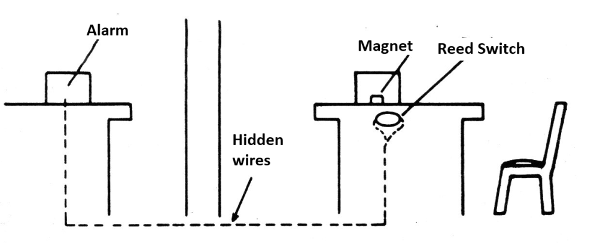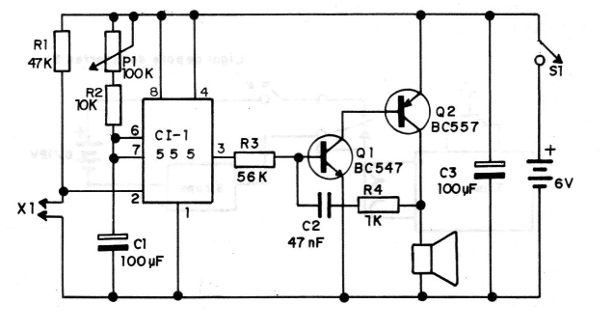A reed-switch is hidden under the table and in the piece a small magnet. Under normal conditions, the magnet is far from reed, but in an emergency situation, for example by pretending to pick up a pen, you move the object to the position where it aligns with the reed-switch and the signal is sent to your desk by means of hidden wires, as shown in figure 1.

The complete diagram is shown in figure 2.

The hidden receiver wire may be common.
The food is made with ordinary batteries that are in the emergency room in the adjoining room next to a desk. The volume of the alarm system is not the biggest to not catch the attention of a possible intruder who is making threats in the main room.
SEMICONDUCTORS
CI-1 - 555 - integrated circuit
Q1 - BC547 or equivalent - NPN transistor of general use
Q2 - BC557 or equivalent - general purpose PNP transistor
RESISTORS
P1 - 100 k - potentiometer
R1 - 47 k - resistor (yellow, violet, orange)
R2 - 10 k - resistor (brown, black, orange)
R3 - 56 k - resistor (green, blue, orange)
R4 - 1 k - resistor (brown, black, red)
CAPACITORS
C1 - 100 uF x 12V - electrolytic capacitor
C2 - 47 nF - ceramic or polyester capacitor
C3 - 100 uF x 12 V - electrolytic capacitor
SEVERAL
B1 - 4 small batteries
X1 - Reed-switch
FTE - 4 or 8 ohm speaker
S1 - Single switch
Printed circuit board, battery holder, mounting box, small permanent magnet attached to an object on the table, wires, solder, etc.



